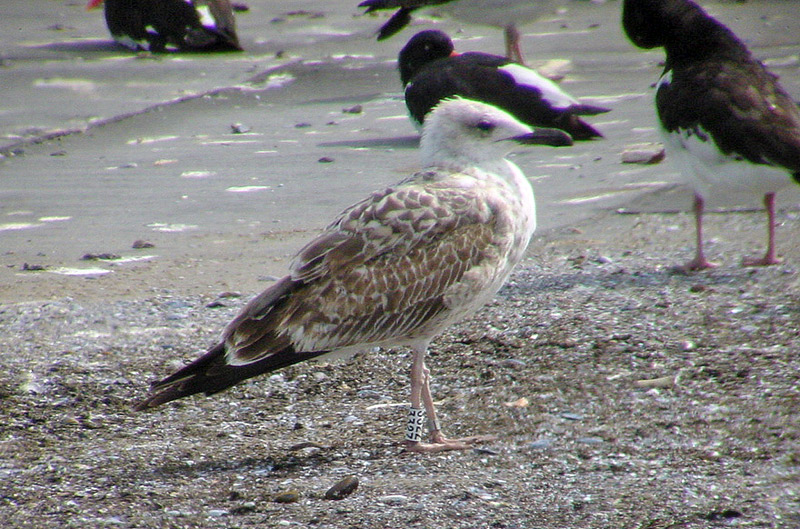 Yellow-legged
Gull - Larus michahellis
Yellow-legged
Gull - Larus michahellis
(last update: October 08 2013)
Coordinators:
Delfín González
Gabriel Martín
Antonio Gutierrez
Amir Ben Dov
Mars Muusse
Yellow-legged Gull michahellis 1CY 332Z July 2002, Dintelhaven - Maasvlakte, September & November 2002 Scheveningen, the Netherlands.
By mid July, already a few scapulars shed in the upper scapulars. Compare the colour of the feather-centres with surrounding recently fledged Lesser Black-backed Gulls. This michahellis, juvenile 332Z was ringed this summer near Marseille, S France. After leaving the colony, it has migrated north, more than 1.000 km's (last days we had strong southern winds). At Dintelhaven, the Netherlands, 332Z arrived in large flocks of very fresh juveniles, gathering near a small sandy beach, just a few 100's meters from the colonies. A small survey showed some Lesser Black-backed Gulls may have shed scapulars as well, with a same moult stage as this michahellis. The main difference between Yellow-legged Gull and LBBG in this period is the "stage of wear" in the fringes of the inner coverts and scapulars.
| juvenile Lesser Black-backed Gull: upper-parts moult score, July 13 2002, Maasvlakte, the Netherlands. | ||
| . | location Dintelhaven | location Papegaaiebek |
| complete juvenile, no wear | 40 | 47 |
| complete juvenile, wear in rear scapulars | 5 | 4 |
| 1-5 upper scapulars missing | 3 | - |
below: michahellis 1CY 332Z July 13 2002, Dintelhaven - Maasvlakte, the Netherlands.

332Z
in front, with LBBG.


below: michahellis 1CY 332Z September 16 2002 Scheveningen, the Netherlands.
Most of the scapulars have been replaced for second generation feathers and the inner wing-coverts and tertials look very abraded by September. One tertial has been replaced in the right wing. The last moulted scapulars have a ginger tone in the centres. Moult of the head-feathers and under-parts is in progress and the head appears 'moth-eaten'. One outer lower lesser has been replaced for 2nd generation.


below: michahellis 1CY 332Z November 15 2002 Scheveningen, the Netherlands.
The scapulars have been replaced for second generation feathers and the inner wing-coverts and tertials look very abraded by November: some feathers have only the shaft left. One tertial has been replaced in the right wing. Two median coverts have been replaced, one outer and two central lower lesser has been replaced for 2nd generation. The head and under-parts are moulted to second generation as well (although the ventral feathers and under-tail coverts are still juvenile) and look pretty neat again.
